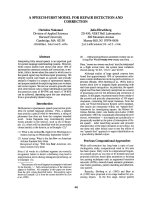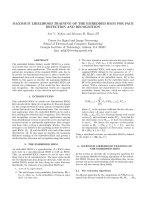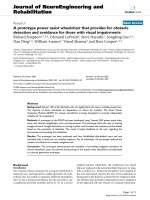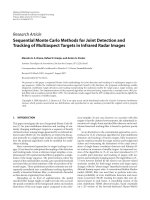Development of multifunctional membranes for visual detection and adsorptive removal of heavy metal ions from aqueous solutions
Bạn đang xem bản rút gọn của tài liệu. Xem và tải ngay bản đầy đủ của tài liệu tại đây (7.48 MB, 173 trang )
DEVELOPMENT OF MULTIFUNCTIONAL MEMBRANES FOR VISUAL
DETECTION AND ADSORPTIVE REMOVAL OF HEAVY METAL IONS
FROM AQUEOUS SOLUTIONS
ZHANG LINZI
NATIONAL UNIVERSITY OF SINGAPORE
2012
DEVELOPMENT OF MULTIFUNCTIONAL MEMBRANES FOR VISUAL
DETECTION AND ADSORPTIVE REMOVAL OF HEAVY METAL IONS
FROM AQUEOUS SOLUTIONS
ZHANG LINZI
(B. Eng., Xi’an Jiaotong University)
A THESIS SUBMITTED
FOR THE DEGREE OF DOCTOR OF PHILOSOPHY
DEPARTMENT OF CIVIL AND ENVIRONMENTAL
ENGINEERING
NATIONAL UNIVERSITY OF SINGAPORE
2012
DECLARATION
I hereby declare that the thesis is my original work and it has been written by me in its
entirety. I have duly acknowledged all the sources of information which have been
used in the thesis.
This thesis has also not been submitted for any degree in any university previously.
__________________________________________
Zhang Linzi
May 1
st
, 2012
i
ACKNOWLEDGEMENTS
First and foremost, I would like to express my heartfelt gratitude to my supervisor,
Associate Professor Bai Renbi, for his sincere help and guidance, continuous support
and encouragement throughout my Ph.D. study. His passion and intuition in scientific
research have deeply inspired me and enriched my growth as a student, a researcher
and a scientist that I want to be. I have broadened my knowledge as well as developed
my research planning and
scientific writing
skills under his kind supervision. His
enthusiasm, sincerity and meticulous attitude towards scientific research have greatly
impressed me and will benefit to my life-long study.
Acknowledgement also goes to my colleagues for their help and assistant, especially
to Dr. Li Nan, Dr. Liu Changkun, Dr. Han Wei, Dr. Wee Kin Ho, Dr. Zhao Yonghong,
Dr. Han Hui, Dr. Zhu Xiaoying and Ms. Tu Wenting. I would also appreciate the
assistance and cooperation from all lab and administrative officers in the Department
of Civil and Environmental Engineering, National University of Singapore. In
addition, I would also like to show my special thanks to Ms. Ge Xiaomeng and her
mother Madam Su Yeming for their help and support during the days I live with them
in Singapore.
Last but not the least, I would like to give my dearest thanks to my parents, Mr. Zhang
Yanyuan and Madam Lin Aiping, my grandmother Madam Qu Juying, my late
grandfather Mr. Lin Yunhu and all my relatives for their continuous and infinite love,
support and encouragement.
ii
Table of Contents
ACKNOWLEDGEMENTS i
SUMMARY v
LIST OF TABLES vii
LIST OF FIGURES viii
NOMENCLATURE xiii
CHAPTER 1 INTRODUCTION 1
1.1 Overview 2
1.2 Research objectives and scopes of the work 4
CHAPTER 2 LITERATURE REVIEW 8
2.1 Heavy metal 9
2.2 Heavy metal pollution 10
2.2.1 Lead (Pb) 13
2.2.2 Cadmium (Cd) 13
2.2.3 Mercury (Hg) 14
2.3 Heavy metal removal technology 15
2.4 Heavy metal monitoring technology 22
2.4.1 Instrumental analysis 24
2.4.2 Chemical sensor 25
2.4.3 Optical chemical sensor with visual detection property 28
2.5 Significance of this study 32
CHAPTER 3 DEVELOPMENT OF A NOVEL MULTIFUNCTIONAL
MEMBRANE FOR VISUAL DETECTION AND ADSORPTIVE REMOVAL OF
LEAD(II) IONS IN AQUEOUS SOLUTIONS 34
3.1 Introduction 36
3.2 Materials and methods 37
3.2.1 Materials 37
3.2.2 Preparation of porous CS/CA blend membrane 37
3.2.3 Immobilization of DZ on CS/CA membrane 38
3.2.4 Experiments for chromatic response of the membranes in detection of lead
ions in solutions 38
3.2.5 Lead adsorption experiments 39
3.2.6 Experiments on interference study 41
iii
3.3 Results and discussion 41
3.3.1 Mechanisms of DZ immobilization and DZ interaction with lead ions 41
3.3.2 Effect of solution pH 42
3.3.3 Effect of contact time 43
3.3.4 Effect of lead concentration 43
3.3.5 Adsorption kinetics of lead ions on the membrane 45
3.3.6 Adsorption isotherms 46
3.3.7 Interference of other cations 49
3.3.8 Reusability of the prepared membrane 50
3.4 Conclusion 51
CHAPTER 4 SIMULTANEOUS DETECTION AND REMOVAL OF MERCURY
IONS IN AQUEOUS SOLUTIONS BY TPPS FUNCTIONALIZED CS/CA
MULTIFUNCTIONAL MEMBRANE 52
4.1 Introduction 54
4.2 Materials and Methods 57
4.2.1 Preparation of multifunctional membrane 57
4.2.2 Performance evaluation through batch adsorption experiments 58
4.2.3 Performance evaluation through batch filtration experiments 59
4.2.4 Other analyses 60
4.3 Results and Discussion 62
4.3.1 Membrane characteristics 62
4.3.2 Optical response of CS/CA-TPPS membrane to Hg(II) ions in water 65
4.3.3 Effect of TPPS immobilization amount on the performance of CS/CA-TPPS
membrane 66
4.3.4 Effect of pH on the performance of CS/CA-TPPS membrane 70
4.3.5 Effect of ionic strength on the performance of CS/CA-TPPS membrane 72
4.3.6 Influence of initial Hg(II) concentration on the performance of CS/CA-
TPPS membrane 73
4.3.7 Interference of other metal ions on the performance of CS/CA-TPPS
membrane 74
4.3.8 Desorption 76
4.3.9 Application to real water samples 78
4.4 Conclusion 80
CHAPTER 5 THE EFFECT OF HUMIC ACID ON THE DETECTION AND
REMOVAL OF HG(II) FROM AQUEOUS SOLUTIONS BY THE CS/CA-TPPS
MEMBRANE 82
5.1 Introduction 85
5.2 Methods and Materials 88
5.2.1 Materials 88
iv
5.2.2 Experiments 88
5. 3 Result and discussion 91
5.3.1Batch adsorption 91
5.3.2 Filtration performance 100
5.4 Conclusion 108
CHAPTER 6 A VERSATILE METHOD FOR THE IMMOBILIZATION OF
OPTICAL INDICATORS ON THE BASE MEMBRANE: APPLICATION TO
CADMIUM(II) 110
6.1 Introduction 112
6.2 Materials and methods 114
6.2.1 Materials 114
6.2.2 Preparation of CS/CA blend base membrane 114
6.2.3 Grafting of polymer brushes on CS/CA base membrane for indicator
immobilization 115
6.2.4 Coupling of cadmium indicator (TMPyP) onto CS/CA-SMP membrane . 116
6.2.5 Characterization of membranes 117
6.2.6 Experiments for examining chromatic response of the membranes in
detecting cadmium ions in solutions 117
6.2.7 Cadmium adsorption performance experiments 118
6.2.8 Experiments on interference study 120
6.3. Results and discussion 120
6.3.1 Functionalization of membrane surface for cadmium ions 120
6.3.2 Morphology and permeability of prepared membranes 126
6.3.3 Response time of CS/CA-SMP-TMPyP membrane to cadmium detection
127
6.3.4 Effect of pH on cadmium detection by the prepared membrane 128
6.3.5 Response of CS/CA-SMP-TMPyP membrane in detecting cadmium ions
with different concentrations 131
6.3.6 Adsorption performance 132
6.3.7 Interference of coexisting ions 136
6.4 Conclusion 137
CHAPTER 7 CONCLUSIONS AND RECOMMENDATIONS 138
7.1 Conclusions 139
7.2 Recommendations and future work 142
REFRENCE 145
LIST OF PUBLICATIONS 155
v
SUMMARY
As a result of increased industrial and urban activities, the occurrence of heavy metal
contaminants has been dramatically augmented. Heavy metal contaminants are often
introduced into the environment through the effluents discharged from various
industries such as electroplating, mining, electric device manufacturing and metal
finishing. They are toxic, non-biodegradable and highly carcinogenic, thus posing a
serious threat to the lives of human beings even at low concentrations. This
necessitates the development of technologies that can effectively detect the presence
of heavy metal ions as well as remove them from the contaminated waters.
In recent years, optical sensors have been regarded as an effective method for water
quality monitoring due to their advantages of simple and naked-eye detection that
requires minimum labor and less sophisticated equipments. Whilst, in the field of
heavy metal removal, adsorptive membranes have appeared as a novel membrane
technology that attracted considerable research attention due to their high efficiency
and low energy consumption even when the heavy metal containments are at
relatively low concentrations. Over the decades, adsorptive membranes and optical
sensors have been developed respectively in their individual disciplines. There is a
desire to explore the possibility of incorporating the two technologies together for
simultaneous on-site and in-situ detection and removal of heavy metal ions. This
innovation may open the prospect of an integrated system for simultaneous water
treatment and water quality surveillance. It may also have distinct advantages in
actual applications, such as enhancing the treatment efficiency, simplifying the
treatment system and reducing the environmental footprint.
vi
In the present work, attempts were made to develop multifunctional membranes for
visual detection and removal of heavy metal ions in aqueous solutions. Lead (Pb),
mercury (Hg) and cadmium (Cd) were selected as the target ions due to their high
occurrence in industrial wastewaters and high toxicity to the public and environmental
health. Different types of optical indicators were immobilized onto chitosan/cellulose
acetate (CS/CA) blend membrane through different methods based on their individual
physiochemical properties. The effects of various factors, including the amount of
immobilized indicators, solution pH, solution ionic strength, initial heavy metal
concentrations, the presence of interference ions and co-existed organic contaminants
were investigated through a series of experiments. The results in this study proved the
concept of multifunctional membrane for simultaneous visual detection and removal
of heavy metal ions was feasible and achievable. The prepared multifunctional
membranes can detect and remove heavy metal ions in a wide variation of solution
conditions, and the used membranes can be regenerated and reused without significant
loss of their functionalities. Therefore, the proposed multifunctional membrane
technology demonstrates a great potential in the remediation of heavy metal
contamination, especially for the remote areas where there is a lack of or not
convenient to use sophisticated instruments.
vii
LIST OF TABLES
Table 2.1 Drinking water regulations on heavy metal contaminants (USEPA,
NPDWR).
Table 2.2 Typical energy consumption and product recovery values for various
membrane systems (Metcalf
and Eddy 2004).
Table 2.3 Advantages and disadvantages of membrane treatment technologies
(Metcalf
and Eddy 2004).
Table 2.4 Heavy metals contamination caused by natural or man-made disasters.
Table 3.1 Parameters of Langmuir and Freundlich isotherms for adsorption of Pb(II)
ions on the membranes (CS/CA, CS/CA-DZ) at initial pH5, 22-23 .
Table 3.2 Color response of 1mg/L Pb(II) ions in presence of interfering cations in
the solutions (initial pH5, 22-23 ).
Table 4.1 Characteristic property of CS/CA and CS/CA-TPPS membranes
Table 4.2 Immobilized TPPS amounts on various CS/CA-TPPS multifunction
membranes.
Table 4.3 Effect of initial Hg(II) concentrations on the adsorption amount of Hg(II)
on the membrane (mg/g) and the residual Hg(II) concentration in the
solution (initial pH6, 22-23 , 100mL of solution volume, 0.02g
membrane, contact time 300min).
Table 4.4 The concentrations of major dissolved components in the various real
water samples
Table 5.1 Results of pseudo second-order kinetics model fitted to experiment data
of Hg(II) adsorption on CS/CA-TPPS and CS/CA-TPPS-HA at different
initial solution pH values.
Table 6.1 Pure water fluxes (PWF) of CS/CA, CA/CA-SMP and CS/CA-SMP-
TMPyP membranes (22-23 ).
Table 6.2 The fitting parameters of the Langmuir and Freundlich isotherm models
to the adsorption data of Cd(II) on the membranes of CS/CA, CS/CA-
SMP-TMPyP (initial pH8, 22-23 ).
Table 6.3 Uptake of Cd(II) by CS/CA-SMP-TMPyP membrane in the presence of
other cations.
viii
LIST OF FIGURES
Fig. 2.1 Chemical structure of chitosan.
Fig. 2.2 Comparison of morphology of the CS/CA membrane with higher
CS/CA ratio (3-12) as compared to that with a lower CS/CA ratio
(2-18) (Liu and Bai, 2006b).
Fig.2.3 Schematic representation of the composition and function of a
chemical sensor (Lobnik 2006).
Fig.2.4 Classification of chemical sensor according to the operation
principle of the receptor and transducer (Lobnik 2006).
Fig. 2.5 Formation of ion-indicator complex.
Fig. 3.1 Schematics showing the immobilization mechanism of DZ on
CS/CA base membrane and the reaction with Pb(II) ions.
Fig. 3.2 Chromatic change of CS/CA-DZ in 5mg/L lead solutions at
different initial pH values (22-23 ).
Fig. 3.3 The kinetic response of CS/CA-DZ membrane in the detection of
5mg/L lead solution at initial pH5, 22-23 . (a) Color transition
pattern (b) UV/Vis spectra.
Fig. 3.4 (a) Color change and (b) UV/Vis spectra of CS/CA-DZ in response
to Pb(II) ions with concentrations ranging from 0.1mg/L to
200mg/L at initial pH5, 22-23 (A and A
0
are the absorption
intensities of the CS/CA-DZ membranes at 490nm after and
before reacting with Pb(II) ions).
Fig. 3.5 Kinetic adsorption results of lead ions on CS/CA and CS/CA-DZ
membranes (C
0
=10mg/L, initial pH5; 22-23 ). Error bars are
determined from three repeated tests, with errors<5%.
Fig. 3.6 Experimental adsorption isotherm data and the fitted results of the
Langmuir and Freundlich isotherm models to the experimented
data. Error bars are determined from three repeated tests, with
errors<5% (initial pH5; 22-23 ).
Fig. 4.1 Schematic of the unit used for filtration study
Fig. 4.2 SEM images showing the morphologies of CS/CA and CS/CA-
TPPS membranes.
Fig. 4.3 FTIR spectra of (a) TPPS powder; (b) CS/CA base membrane; (c)
CS/CA-TPPS multifunctional membrane
ix
Fig. 4.4 Response of CS/CA-TPPS membrane to Hg(II) ions in a solution
with the contact time: (a) optical color change and (b) variation of
UV/Vis light absorbance spectrum versus wavelength (TPPS
immobilized amount 1.0mg/g, 0.02g membrane, 100mL of
solution, initial Hg(II) concentration 1mg/L, initial pH6, 22-23 ).
Fig. 4.5 Performance of CS/CA-TPPS membranes with different amounts
of TPPS immobilized in detection and adsorptive removal of
Hg(II): (a) kinetic variation of color changes; (b) variation of
UV/Vis light absorbance intensity (in terms of A-A
0
) at 450nm;
and (c) Hg(II)
uptake amounts (initial Hg(II) concentration:
200µg/L, initial pH6, 22-23 , 100mL of solution volume, 0.02g
membrane; A and A
0
are UV/Vis light absorbance intensity of the
membrane at 450nm before and after in contact with Hg(II) ions in
the solution).
Fig. 4.6 Proposed detection (color change) and adsorption enhancement
mechanism of Hg(II) by CS/CA-TPPS multifunctional membrane.
Fig. 4.7 Effect of initial solution pH on the performance of CS/CA-TPPS
membrane (a) color change of the membrane after 20min contact
time; (b) Hg(II) adsorption uptakes from solutions with initial pH
ranging from 4 to 8 (22-23 , initial Hg concentration 200µg/L,
100mL of solution volume, 0.02g membrane).
Fig. 4.8 Effect of ionic strength on the performance of CS/CA-TPPS
multifunctional membrane: (a) variation of UV/Vis light
absorbance intensity (A-A
0
) of the membrane at 450nm and (b)
adsorption uptakes of Hg(II) by the membrane (200µg/L Hg(II)
ions in the solutions with different ionic strength ranging from 0 to
0.2M NaNO
3
(initial pH6, 22-23 , 100mL of solution volume,
0.02g membrane). Note: The photos in the insert of Fig. 4.8(a)
were the membrane samples after 20min contact with the Hg(II)
solutions.
Fig. 4.9 Color change of CS/CA-TPPS multifunctional membrane in Hg(II)
solutions with different initial Hg(II) ion concentrations (initial
pH6, 22-23 , 100mL of solution volume, 0.02g membrane).
Fig. 4.10 Effect of interference metal ions on the performance of the
CS/CA-TPPS membrane: (a) the developed color; (b) the UV/Vis
light absorption difference (in terms of A-A
0
) at 450nm after 5min
of contact time with the Hg(II) solutions and (c) Hg(II) adsorption
uptakes after 300min of contact time with the Hg(II) solutions
(initial pH6, 22-23 , Hg(II) concentration 10
-6
M, other cation
concentrations 10
-4
M, 0.02g membrane).
Fig. 4.11 Results from the adsorption and desorption experiments: (a)
x
mercury uptake amount and (b) changes in the light absorbance
intensity and developed color in the adsorption and desorption
cycles (initial pH6, 22-23 , initial Hg concentration 10mg/L,
0.02g membrane).
Fig. 4.12 (a) Color change of the membrane after filtration of and (b)
Removal rate of Hg (II) from the various simulated Hg(II)
contaminated natural water samples (initial mercury concentration
200µg/L; 22-23 ; membrane area 11.8cm
2
; applied pressure
1bar).
Fig. 5.1 Results of individual (a) Hg(II) (800µg/L) and (b) HA (15mg/L)
adsorption on CS/CA-TPPS membrane in solutions with initial pH
from 6.5 to 8.5. (22-23 , 0.02g membrane and 100mL solution
for each adsorption, inserted photos were obtained after the
contact time of 5min for Hg(II) solution and 300min for HA
solution).
Fig. 5.2 Results of sequential adsorption. (a) Hg(II) (800µg/L) adsorption
on CS/CA-TPPS-HA membrane; and (b) HA (15mg/L) adsorption
on CS/CA-TPPS-Hg membrane in solutions with initial pH from
6.5 to 8.5 (22-23 , 0.02g membrane and 100mL solution for each
adsorption, the inserted picture was obtained after 30min of
contact time).
Fig. 5.3 Changes of developed membrane colors in terms of UV/Vis light
absorbance intensity difference (A-A
0
) at 450nm (A
0
and A are the
light absorbance intensities of the membrane surface at 450nm
before and after Hg(II) adsorption).
Fig. 5.4 Desorption results of Hg(II) ions from CS/CA-TPPS-Hg
membrane during sequential adsorption of HA. (a) Hg(II)
desorption amount; (b) changes in absorbance intensity (A’-A
0
’
) at
450nm and (c) the color change of CS/CA-TPPS-Hg membrane
after sequential HA adsorption (22-23 , initial HA concentration
15mg/L, 100mL, 0.02g membrane).
Fig. 5.5 The proposed mechanisms of sequential adsorption of (a) Hg(II)
and (b) HA on CS/CA-TPPS membrane.
Fig. 5.6 Result of co-adsorption of 800g/L Hg(II) and 15mg/L HA in the
same solution (a) Hg(II) adsorption; (b) HA adsorption; (c)
membrane color after adsorption 300min (22-23 , 100mL
solution, initial pH6.5-8.5, 0.02g membrane).
Fig. 5.7 The color response and Hg(II) uptake amount (q
e
) of CS/CA-
TPPS membrane in Hg(II) and HA mixed solution (22-23 ,
initial Hg concentration 800µg/L, initial HA concentration from 2,
8, or 15mg/L, initial pH6.5, 100mL solution, 0.02g membrane).
xi
Fig. 5.8 Result of Hg(II) solution filtration by CS/CA-TPPS membrane (a)
Removal rate of Hg(II) and (b) membrane color change after
filtration of Hg(II) (22-23 , initial Hg concentration 800µg/L,
initial pH6.5, membrane area 11.8cm
2
, applied pressure 1 bar,
filtration duration 150min, permeate flux 12.3L/m
2
·h).
Fig. 5.9 Result of HA solution filtration. (a) Removal rate of HA and (b)
membrane colors after filtration of HA by CS/CA-TPPS
membrane (22-23 , initial HA concentration 15mg/L, initial
pH6.5, membrane area 11.8cm
2
, applied pressure 1 bar, filtration
duration 150min, permeate flux dropped continuously from
11.5L/m
2
·h to 7.4 L/m
2
·h).
Fig. 5.10 Filtration of Hg(II) solution by CS/CA-TPPS-HA membrane. (a)
Removal rate of Hg(II) and (b) the membrane colors before and
after sequential Hg solution filtration (22-23 , Initial Hg(II)
concentration 800µg/L, initial pH6.5, membrane area 11.8cm
2
,
applied pressure 1 bar, filtration duration 150min, permeate flux
around 7.3L/m
2
·h).
Fig. 5.11 Filtration of HA solution by CS/CA-TPPS-Hg membrane. (a)
Removal rate of HA and (b) the developed color after HA
filtration (22-23 , Initial HA concentration 15mg/L, initial pH6.5,
membrane area 11.8cm
2
, applied pressure 1 bar, filtration duration
150min, permeate flux dropped continuously from around
12.1L/m
2
·h to 8.3L/m
2
·h).
Fig. 5.12 Desorption of Hg(II) from CS/CA-TPPS-Hg membrane in the
sequential filtration of 15mg/L HA solution.
Fig. 5.13 Filtration of the solution containing 800µg/L Hg and 15mg/L HA.
Removal rate of (a) Hg(II); (b) HA and (c) the membrane color
before and after the filtration (22-23 , initial pH6.5, membrane
area 11.8cm
2
, applied pressure 1bar, filtration duration 150min,
permeate flux continuously dropped from 11.2L/m
2
·h to
6.7L/m
2
·h).
Fig. 5.14 Filtration of solutions containing both HA and Hg(II) at different
HA/Hg(II) ratios. Removal rate of (a) Hg(II), (b) HA and (c) the
membrane color changes before and after the filtration runs (22-
23 , initial Hg(II) concentration 800µg/L, initial HA
concentration 2mg/L, 8mg/L and 15mg/L, respectively, initial
pH6.5, membrane area 11.8cm
2
, applied pressure 1 bar, filtration
duration 150min).
Fig. 6.1 Mechanism of ATRP.
Fig. 6.2 Schematic representation of the processes to obtain the
multifunctional membrane. (a) Immobilization of the surface
initiator and the polymerization of negatively charged monomer
xii
(SMP) on CS/CA base membrane surface; (b) coupling of TMPyP
molecules to obtain CS/CA-SMP-TMPyP; (c) interaction between
cadmium ions and CS/CA-SMP-TMPyP membrane.
Fig. 6.3 FTIR spectra of (a) TMPyP powder; (b) CS/CA base membrane;
(c) surface initiated CS/CA membrane; (d) CS/CA-SMP
membrane; (e) CS/CA-SMP-TMPyP membrane.
Fig. 6.4 UV/Vis spectra of (a) initial TMPyP solution; and final TMPyP
solution after adsorption equilibration with (b) CS/CA base
membrane; and (c) CS/CA-SMP membrane
Fig. 6.5 SEM image of (a) CS/CA base membrane; (b) surface initiated
CS/CA membrane; (c) CS/CA-SMP membrane; (d) CS/CA-SMP-
TMPyP membrane.
Fig. 6.6 Color change of CS/CA-SMP-TMPyP membrane in responding to
Cd(II) ions with (a) different contact time (C
0
=50mg/L, initial pH8,
22-23 ); (b) different initial solution pH values (C
0
=50mg/L, 22-
23 ); (c) different initial concentrations (contact time: 20min,
initial pH8, 22-23 ).
Fig. 6.7 UV/Vis spectra in time response of CS/CA-SMP-TMPyP
membrane for detecting Cd(II) ions (C
0
=50mg/L, initial pH8, 22-
23 ).
Fig. 6.8 Difference in the absorbance intensity at 445nm for CS/CA-SMP-
TMPyP membrane in response to cadmium solution with (a)
different initial pH values; (b) different concentrations. The A
0
and
A are the absorption signal responses of the CS/CA-SMP-TMPyP
membranes at 445nm before and after equilibrating with Cd(II)
ions
Fig. 6.9 Kinetic adsorption results of cadmium ions on CS/CA and CS/CA-
SMP- TMPyP membrane (C
0
=50mg/L, initial pH8, 22-23 ).
Error bars are determined from three repeated tests, with
errors<5%.
Fig. 6.10 Fitting of pseudo second-order kinetic adsorption model to
experimental results of cadmium ion adsorption on CS/CA base
membrane and on CS/CA-SMP-TMPyP membrane
Fig. 6.11 Experimental adsorption isotherm data and the fitted results of the
Langmuir and Freundlich isotherm models to the experimental
data. Error bars are determined from three repeated tests, with
errors<5% (initial pH8, 22-23 ).
xiii
NOMENCLATURE
AAS Atomic Absorption Spectrometry
ACDA 2-amino-l cyclopentene-l dithiocarboxylic acid
AFS Atomic Fluorescence Spectrometry
ATRP Atom Transfer Radical Polymerization
ATSDR Agency for Toxic Substances and Disease Registry
BE Binding Energy
BPY 2’2-bipyridyl
CA Cellulose Acetate
CS Chitosan
CS/CA membrane Chitosan/Cellulose Acetate blend membrane
CS/CA-DZ membrane DZ immobilized on CS/CA membrane
CS/CA-SMP SMP grafted CS/CA membrane
CS/CA-SMP-TMPyP TMPyP immobilized on SMP grafted CS/CA membrane
CS/CA-TPPS membrane TPPS functionalized CS/CA membrane
DPC 1.5-diphenylcarbazide
DZ Dithizone
EDTA Ethylenediamine Tetra-acetic Acid
FA Formic Acid
FTIR/ATR Attenuated Total Reflectance Fourier Transform Infrared
Spectroscopy
FOCS Fiber optic chemical sensor
HA Humic Acid
ICP Inductively Coupled Plasma
ICP-OES Inductively Coupled Plasma-Optical Emission
xiv
Spectrometer
MCL Maximum Contaminant Level
MCLG Maximum Contaminant Level Goal
MF Microfiltration Membrane
MWCO Molecular Weight Cut-Off
NF Nanofiltration Membrane
NOM Natural Organic Matter
NPDWR National Primary Drinking Water Regulation
PWF Pure Water Flux
RO Reverse Osmosis Membrane
SEM Scanning Electron Microscope
SiNW Silicon nanowires
SMP 3-Sulfopropyl methacrylate potassium salt
TEA Triethylamine
THF Tetrahydrofuran
TMPyP 5,10,15,20-Tetrakis (1-methyl-4-pyridinio) porphyrin tetra
(p-toluenesulfonate)
TPPS 5,10,15,20-tetraphenolporphine tetrasulfonic acid
TT Treatment Technique
UF Ultrafiltration Membrane
USEPA U.S. Environmental Protection Agency
USFDA U. S. Food and Drug Administration
XRF X-Ray fluorescence
1
CHAPTER 1 INTRODUCTION
2
1.1 Overview
Heavy metals are natural components of the Earth’s crust. Their unique properties,
including malleability, ductility, resistance to corrosion, high electric and thermal
conductivity, make them undoubtedly crucial to the development of human society.
Some heavy metals such as copper, selenium and zinc are essential to human body as
trace elements to maintain a proper metabolism. However, excessive intake of heavy
metals may have detrimental effects to mental and central nervous systems, blood
composition, lungs, kidneys, liver and other vital organs. Heavy metals cannot be
degraded through the biological metabolism could not be easily excreted from the
body. Once entering the human body, even in a small amount, they will accumulate in
organs and tissues, and eventually develop chronic toxic effects, such as physical,
muscular and neurological degeneration, Parkinson’s disease, muscular dystrophy,
multiple sclerosis and cancer (de Castro Dantas et al. 2001; Inglezakis et al. 2003;
Sanyal et al. 2005 ).
Ever since the first industrial revolution, heavy metal contaminants have been
dramatically increased due to the intensified industrial and urban activities. The major
source of heavy metal contaminants is usually from the wastewaters of industries such
as electroplating, mining, electric device manufacturing, and metal finishing.
Improper effluent discharge, insufficient treatment or poor management of the
industrial wastes has introduced an excessive amount of heavy metal contaminants
into the natural water system (rivers, lakes and seas), thus posing a great threat to the
lives of human beings and other living organisms. Therefore, in order to safeguard the
environmental and public health, it is greatly desirable to develop technologies that
can effectively warn the presence of heavy metal ions as well as remove them from
3
the contaminated water.
With the emphasis on water safety and security enhancement in recent years, many
efforts have been devoted to develop on-site and in-situ monitoring of heavy metal
ions. Among all the technologies, optical sensors have attracted considerable research
attention in recent years. Unlike the conventional detection methods such as machine-
based analysis devices, optical sensors depending on naked-eye recognition require
minimum labor and less sophisticated equipment (Klimant and Otto 1992). The
mechanism of the optical sensors is based on the use of optical indicators that can
generate and transduce optical signal, i.e., color change, as a response to the presence
of certain metal species. For the convenience of applications, the optical indicators are
usually immobilized onto solid supporting materials (Balaji et al. 2006).
In the meantime, technologies for heavy metal removal have also been extensively
developed.
Adsorptive membrane is one of the most promising technologies that are
newly developed in recent years. The adsorptive membrane is usually a type of porous
membrane bearing functional groups on its external and internal surfaces. These
functional groups, such as –COOH, –SO
3
H or –NH
2
, can bond with heavy metal ions
through the surface complexation or ion exchange mechanism. Thus, heavy metal
ions that are usually at relatively small amounts can be removed from the passing
liquid (e.g. water or wastewater) when they are in contact with the membrane surface,
even though the dimensions of the metal ions to be removed are much smaller than
the pore sizes of the membrane. In comparison with the conventional porous
membranes that are designed for the removal of particles with relatively large sizes,
the adsorptive membrane provides the additional advantages of efficiently removing
4
dissolved heavy metal ions, as that could only be achieved by the conventional
nanofiltration or reverse osmosis membranes but with much lower energy
consumption and higher permeate flux (Liu and Bai 2006a). Although various
adsorptive membranes have been developed, chitosan-based adsorptive membrane has
appeared to be a promising type. Chitosan (CS) is a biopolymer that widely exists in
the shells of crustaceans such as shrimps, crabs, lobsters, and can be easily obtained
from seafood processing wastes. The presence of a large percentage of free amine and
hydroxyl groups on chitosan structure renders it special chemical property that is
particularly suitable for the sorption of heavy metal ions (Guibal 2004).
Over the years, the adsorptive membrane and optical sensor have been developed
individually in their respective disciplines. Therefore, a logical interest is raised to
explore the possibility of combining the two technologies together. So far, however,
there have not been any reported attempts to incorporate adsorptive removal and
optical sensing together in a single membrane system to tackle the issue of heavy
metal pollution. The present work, therefore, intends to bridge the gap by developing
multifunctional membranes for simultaneous visual detection and adsorptive removal
of heavy metal ions from aqueous solutions, which will have significant importance in
heavy metal pollution control and remediation.
1.2 Research objectives and scopes of the work
The main objective of this work is to develop multifunctional membranes that
incorporate the functions of adsorptive removal and visual detection for heavy metal
ions with a filtration membrane. However, we may encounter many challenges or
issues during the innovation, such as how to immobilize optical indicators on the base
5
membranes; how to achieve high performance in the new functions without
compromising the original function of the base membranes, and what are the
influence of water solution compositions on the performance of the developed
multifunctional membranes. In order to tackle the issues mentioned above as well as
explore the applications of the prepared membranes, this research work is carried out
from several aspects and the thesis is organized in the order as described below.
(a) Feasibility of multifunctional membrane concept development
In this study, the first effort was made to immobilize an optical indicator for lead ions,
dithizone (DZ), onto a CS/CA blend adsorptive membrane. The obtained membrane
(CS/CA-DZ) was tested for its optical response as well as adsorption performance
towards lead ions. Experimental results showed that the CS/CA-DZ membrane can
achieve visual detection and adsorptive removal of lead ions simultaneously, proving
that the concept of multifunctional membrane was feasible and practicable.
(b) Extension of multifunctional membrane concept to other heavy metals
Further attempt was made to extend the concept of the multifunctional membrane to
other heavy metal ions. As an illustration, 5,10,15,20-tetraphenolporphine
tetrasulfonic acid (TPPS) functionalized CS/CA membrane was prepared and studied
for its performance in Hg(II) detection and removal. The effects of various factors,
including the amount of immobilized indicator, solution pH, solution ionic strength,
initial Hg(II) concentration and the presence of interference ions, were investigated
through a series of batch adsorption experiments. The performance of the prepared
membrane was tested in both adsorption and filtration with synthetic Hg(II) water
samples and real water samples dosed with Hg(II), respectively. The results showed
6
that the optimum TPPS immobilization amount appeared at 1.0mg (TPPS)/g (dry
membrane) and the prepared membrane exhibited good performance for both visual
detection and adsorptive removal of Hg(II) in solutions with initial pH ranging from 5
to 8. The influence of ionic strength in the solutions was not significant when the ion
concentration was lower than 0.05M (as added NaNO
3
). The interference study
showed that the membrane possessed good selectivity and sensitivity towards Hg(II)
with the presence of other cations, especially alkali and alkaline earth metal ions, even
in their relatively high concentrations. Besides, the used membrane was found to be
effectively regenerated by 0.01M EDTA and could be reused without significant loss
of its functionality. This study has illustrated the potential prospect of the prepared
membrane for the simultaneously warning and removal of mercury ions in water and
wastewater treatment.
(c) Effect of organic pollutants on the performance of the multifunctional membrane
Followed the previous studies, a further work was directed to investigate the effect of
organic contaminants in water on the performance of the multifunctional membrane.
The ubiquitous existence of soluble humic substances in natural water, especially
humic acid (HA), are suspected to affect the performance of the multifunctional
membrane in real applications as HA may influence the speciation, solubility and
transport of heavy metal ions in aqueous solutions; react with indicators and
functional groups on the membrane; or cause fouling of the membrane. In this study,
we investigated the effect of the presence of HA in solutions on the removal and
visual detection of Hg(II) ions by the CS/CA-TPPS membrane prepared in the
previous section. Experiments were conducted in three phases, i.e., batch adsorption
and filtration of individual Hg(II) and HA solutions; sequential adsorption and
7
filtration of individual Hg(II) and HA solutions; co-adsorption and co-filtration of
solutions containing both Hg (II) and HA. The results showed that the existence of
HA would improve the removal of Hg(II) but the sensitivity of visual detection of
Hg(II) by the multifunctional membrane would be compromised when HA existed in
high concentrations. Therefore, the pretreatment for HA removal in the application of
the CS/CA-TPPS membrane may be required if the visual detection of Hg(II) has a
priority in the treatment of water or wastewater.
(d) Explore the advanced and more versatile method for the immobilization of
indicators onto the base membrane
The immobilization of optical indicators onto the base membrane is a key and
challenging step to prepare the multifunctional membranes with desired functions. In
the fourth part of this study, a versatile post-grafting method - atom transfer radical
polymerization (ATRP), was introduced to tackle this issue. 5,10,15,20-Tetrakis (1-
methyl-4-pyridinio) porphyrin tetra (p-toluenesulfonate) (TMPyP), an optical
indicator for cadmium ions which does not have intrinsic affinity to the CS/CA base
membrane was selected as an example for illustration. TMPyP was successfully
immobilized onto the CS/CA membrane via the ATRP method. The method was
proven to be effective and efficient in modifying the membrane surface properties,
which facilitated the immobilization of the optical indicator. Besides, the ATRP
method was also found to improve the adsorption capacity of the membrane by
introducing more functional groups through the grafted polymer brushes on the
membrane surface. Therefore, this method is regarded as a facile and versatile
strategy to design the surface of the membranes for the advanced development in
multifunctional membrane technology.
8
CHAPTER 2 LITERATURE REVIEW









